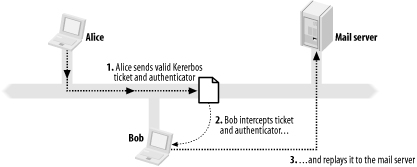Replay Attacks
Another attack that can be mounted against Kerberos is known as a replay attack. Since all protocol exchanges are simply electronic messages that are sent over a computer network, an attacker can listen to the network messages involved in a successful authentication exchange, make a copy of the messages, and replay them at a later time. The attacker doesn’t need to guess the users’ password or decrypt any messages in this scenario. Since the replay attack requires access to listen to all network messages as well as the ability to send fake messages, a replay attack is an active attack . A theoretical replay attack is pictured in Figure 6-1.
 |
In this figure, we see that Alice (the innocent end user) successfully obtains tickets to authenticate to her mail server. Bob, the evil hacker, is surreptitiously listening to all network traffic between Alice, the mail server, and the Kerberos KDC. Bob cannot directly use the TGT that Alice requests in the first step, since the TGT must be decrypted with Alice’s password, which Bob does not know (although he can certainly try to brute-force the password, as discussed in the previous section). However, when Alice sends her encrypted ticket and authenticator, Bob can intercept that message and replay it to impersonate Alice to the mail server.
The ticket is encrypted with the mail server’s key, and ...
Get Kerberos: The Definitive Guide now with the O’Reilly learning platform.
O’Reilly members experience books, live events, courses curated by job role, and more from O’Reilly and nearly 200 top publishers.

